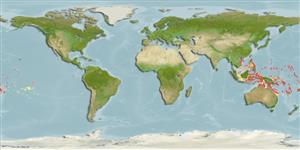>
Gobiiformes (Gobies) >
Gobiidae (Gobies) > Gobiinae
Etymology: Istigobius: Greek, istios = sail + Latin, gobius = gudgeon (Ref. 45335).
More on author: Herre.
Environment: milieu / climate zone / depth range / distribution range
Ecologia
marinhas associadas(os) a recifes; intervalo de profundidade 0 - 30 m (Ref. 1602). Tropical; 20°N - 25°S
Western Pacific: Philippines and Indonesia to Kiribati and Fiji, south to Rowley Shoals in the eastern Indian Ocean and the Great Barrier Reef. Reported from the Ryukyu Islands (Ref. 559).
Tamanho / Peso / Idade
Maturity: Lm ? range ? - ? cm
Max length : 10.8 cm TL macho/indeterminado; (Ref. 11344)
Espinhos dorsais (total) : 7; Raios dorsais (total) : 10 - 11; Espinhos anais: 1; Raios anais : 9 - 10; Vértebras: 26. Upper pectoral fin rays entire. Predorsal with 7-9 cycloid scales; trunk with ctenoid scales. Segmented and non branching caudal rays 4, branching 13. Body color yellowish white; 2 brown diagonal lines from preoperculum to upper jaw, connected by a single line; 2 almost vertical brown lines on operculum. 4th spine of 1st dorsal fin longest. No sharp distinction between sexes in pigmentation and elongation of 2nd dorsal, pelvic and anal fins. Males sometimes with 3-4 dusky vertical bars on abdomen (Ref. 420); fully united pelvic fins with well-developed frenum; longitudinal scale series 29-32; predorsal scales 7-9, reaching interorbital space; absence of scales on cheek or opercle; depth of body 4.7-6.1 in SL (Ref. 90102).
Solitary (Ref. 90102). Occurs in sandy areas with living corals and coral rubble in clear waters, Ref. 48637.
Ciclo de vida ou comportamento de acasalamento
Maturidade | Reprodução | Desova | Ovos | Fecundidade | Larvas
Genital papilla of male terminating to side of anal spine. Papilla of female truncate and terminating posteriorly well before origin of anal fin.
Murdy, E.O. and D.F. Hoese, 1985. Revision of the gobiid fish genus Istigobius. Indo-Pac. Fish. (4):41 p. (Ref. 420)
Status na Lista Vermelha da UICN (Ref. 130435: Version 2024-2)
Ameaça para os humanos
Harmless
Uso pelos humanos
Ferramentas
Relatórios especiais
Baixar XML
Fontes da internet
Estimates based on models
Preferred temperature (Ref.
123201): 25.5 - 29.3, mean 28.6 °C (based on 1556 cells).
Índice de diversidade filogenética (Ref.
82804): PD
50 = 0.5010 [Uniqueness, from 0.5 = low to 2.0 = high].
Bayesian length-weight: a=0.00724 (0.00339 - 0.01546), b=3.10 (2.92 - 3.28), in cm total length, based on LWR estimates for this (Sub)family-body shape (Ref.
93245).
Nível Trófico (Ref.
69278): 3.3 ±0.4 se; based on size and trophs of closest relatives
Resiliência (Ref.
120179): Elevada, tempo mínimo de duplicação da população menor que 15 meses (Preliminary K or Fecundity.).
Fishing Vulnerability (Ref.
59153): Low vulnerability (10 of 100).
Nutrients (Ref.
124155): Calcium = 130 [59, 246] mg/100g; Iron = 0.752 [0.389, 1.441] mg/100g; Protein = 17.9 [16.0, 19.7] %; Omega3 = 0.0927 [, ] g/100g; Selenium = 25.7 [12.3, 56.5] μg/100g; VitaminA = 120 [32, 410] μg/100g; Zinc = 1.97 [1.28, 2.90] mg/100g (wet weight);
